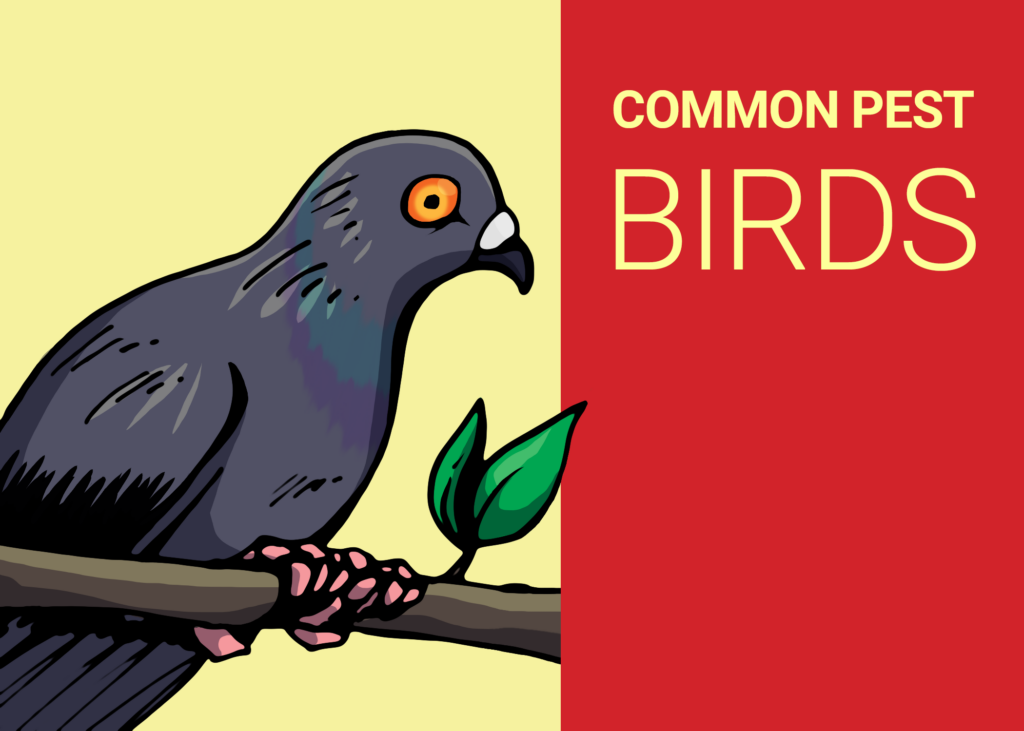When you think of pests getting into your home, your first thought may not be birds. But nonetheless, some birds can be quite pesky, especially if they find cozy lodgings in your roof or attic. Some of the most common pest birds to be aware of are the common pigeon, the European starling and the house sparrow.

Common pigeon
These birds are easily recognizable by their red feet, grey and black plumage and black bands across their wings and tails. They are usually about a foot long. Pigeons prefer to eat grain, but will often eat human food, as well. They are known to find their meals in spilled trash or open trash cans. They usually make nests above ground and will take up residence anywhere they can find space, whether that be steeples, voids in roofs, or small openings in attics. These birds are particularly dangerous in that they often carry other pests along with them, such as fleas, mites, ticks and lice. Pigeons and their droppings can also carry a number of bacteria and diseases, such as salmonella, histoplasmosis, cryptococcosis and toxoplasmosis.
Prevent these birds from taking roost near you by making their filling in access openings to potential nesting areas, keeping landing areas hazardous by adding obstructions and by blocking nooks and crannies in roofs. Also, keep trash covered and enclosed so they cannot get into it.
European Starling
Starlings traditionally grow to about 6-9 inches in length. In the warmer months, their bodies are mostly dark and shiny except for on their upper wings and flanks, and their beaks are yellow. In wintertime, their plumage gains light-colored speckles and their beaks turn grey. Starlings usually eat seeds and small invertebrates, such as larval insects, but they will also eat out of trash bins and consume spilled or discarded human food in public places. They will also eat fruit from trees, making them harmful to agriculture. Starling droppings cause the growth of disease-promoting fungus and bacteria and can damage steel and other structural materials. These birds are also known for their loud noisemaking and tend to travel in flocks.
Prevent these birds from nesting near you by closing off any openings larger than one inch, trimming trees to make them inhospitable for nests, obstructing flat surfaces, keeping trash inaccessible and keeping gutters clean to prevent the occurrence of standing water. Also, if you have bird feeders, fill them with seed mixtures that starlings and other pest birds don’t like to eat.
House Sparrow
Sparrows are about 6 inches long with black and brown stripes. They are opportunistic birds that will nest anywhere they can find a secure little spot. Like other pest birds, they will eat seeds and grain, but they will also damage or consume flowers, seedlings, fruits, vegetables and whatever bits of discarded human food they can scavenge. House sparrows are loud and aggressive birds that will fight other desirable songbirds away from nesting and congregating areas, and their droppings contain acids harmful to structural materials and car paint. Their nests are fire hazards and invite the presence of other pests.
Prevent these birds by keeping all discarded food in closed containers and closing gaps and openings larger than ¾ inch to make nesting impossible.
If you have pest birds taking up residence in or near your home, contact Dodson Pest Control! We can help you get rid of them.
